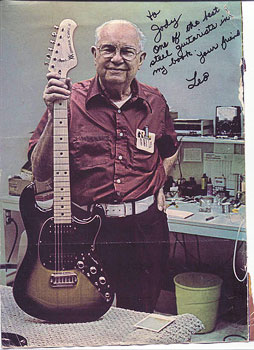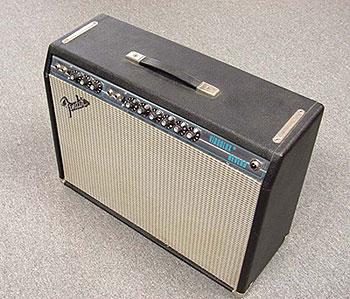Want To Start An Instant Argument? Let’s Talk About ’70s Fenders!
Published on December 5th, 2011 in: Dancing Ourselves Into The Tomb, Issues, Music, Over the Gadfly's Nest |By J Howell
In the exhaustive (and frankly exhausting) world of Internet forum guitar dorkery, few topics seem as sure-fire a heated debate-starter as the mere mention of Fender’s output in the halcyon days of the 1970s. To be fair, even in the mesozoic Internet days of the late ’90s, when I was working in a mostly-vintage-and-used guitar/hi-fi shop, plenty of—ahem—discussion was to be heard nearly any day of the week when it came to Fenders of that period.

Leo Fender, 1978
Photo from Wikipedia
“Those things are all boat anchors!” “Three-bolt necks suck!” “Blackface amps ALWAYS sound better than that silverface junk!” Such opinions could be heard often, though back then as now, an awful lot of the derisive commentary seemed to come from individuals with dubious substantial experience with said guitars and amps. Likewise, there seems to be, at best, an awful lot of conflicting information about the minutiae of what changes were made to what and when in the course of Fender history. Undoubtedly the Seventies were a time of frequent changes for the venerable American guitarmaker.
It should be duly noted at this point that, while I am reasonably knowledgeable, I’m no end-all expert when it comes to most of this stuff. I’m not a Fender historian, nor am I a competent amplifier repair person with vast experience with the nuts and bolts of ’70s Fender amps—or any amps, for that matter—though I’m not completely clueless. I’m just a guy who loves guitars enough to have spent a fair chunk of his younger adult life working in musical instrument retail. That said, I offer my humble $0.02 regarding Fenders of the ’70s:
They RULE.
(At least some of them do.)
Though a thorough account is beyond the scope of this article, and indeed, several books have been written on the topic, a brief bit of Fender history may be useful to the non-guitar nerd reader. Leo Fender sold the Fender Electric Instrument Company to CBS in the spring of 1965. By the late ’60s, changes were being made to much of Fender’s beloved product line. Just how horrible (or not) these changes were and are is, of course, subjective and debatable.
Initially, CBS Fender did little to nothing differently. In fact, in some cases, no changes were made beyond the cosmetic for some time, and even then those changes were slight. Sometime in 1967, CBS Fender changed the look of Fender amps from the black-paneled standard that had been in place since 1960 or so to a shiny new chrome panel, thus beginning the “Silverface” era that lasted until the early ’80s.

1973 Fender Vibrolux Reverb
Here’s where the controversy starts. Some enthusiasts will argue that as soon as 1969, CBS Fender had ruined everything, with horrible circuit changes to beloved amps, mile-thick polyurethane strangling the tone out of guitars that had previously been allowed to “breathe” through a thin nitrocellulose lacquer finish, and a general atmosphere of corporate cheapskatery reducing the once-mighty Fender to purveyors of mass-produced junk.
As with anything, there’s a kernel of truth there, but to dismiss the entire era as worthless is ridiculous. For starters, many of the smaller Fender amps had negligible changes made—especially the smaller end of the line. Aside from eventually using cheaper sources for some parts (that by now, should you have one of these amps, probably need to be replaced—filter capacitors don’t last forever), amps such as the Champ, Vibro-Champ, and Princeton Reverb up to the Deluxe, Vibrolux, and non-reverb Bandmaster stayed mostly unchanged. By the late ’70s, the Princeton and Deluxe had a gain boost for distortion built in, accessible by pulling the volume knob out, but I have it on good authority from more than one credible repair person that if you don’t pull the knob, the circuit remains pretty much the same as a pre-CBS amp.
For anyone inclined to argue that smaller ’70s Fender amps somehow just don’t sound as good, consider this: Jim Campilongo owns and uses three ’70s Princeton Reverbs, two ’70s Vibroluxes (including one with a solid-state rectifier sure to send corque sniffeur tone snobs into orbit), and a ’70s Vibro-Champ. Jim sounds good. REALLY good. Fender released a very limited signature model bearing Jim’s name earlier this year, and he appeared in Fender’s demo video for the reissue of the Princeton upon its release in 2008. At this point, it’s safe to say the guy knows a thing or two about “tone” . . . and he uses ’70s Fender amps more often than not.
Time limit is exhausted. Please reload the CAPTCHA.